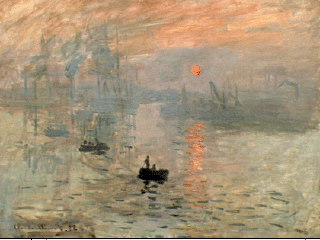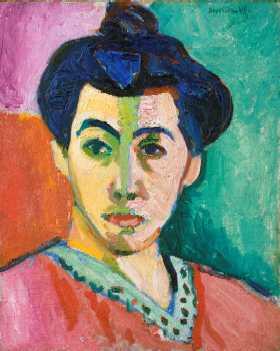Introduction
Impressionism was an art movement that took place in the 19th century. It had a humble beginning: started as an informal association of Paris-based artists, who had begun displaying their work publicly in the 1860s. The name of the movement has its origins in the famous work of Claude Monet, called Impression, Sunrise, which led the critic Louis Leroy to coin the term in a satiric review he wrote in the French newspaper, Le Charivari. He termed Monet’s work a sketch which seemed unfinished: “Impression — I was certain of it. I was just telling myself that, since I was impressed, there had to be some impression in it … and what freedom, what ease of workmanship! Wallpaper in its embryonic state is more finished than that seascape” (Rewald, 1973, p. 323).

Impressionism was heavily inspired by the Romantic colorist Eugene Delacroix, the principal agent behind realism Gustave Courbet and painters belonging to the Barbizon school such as Theodore Rousseau. Other artists who paved the way for Impressionism were Camille Corot and Eugene Boudin, as they owned a style similar to Impressionism and imparted wisdom and knowledge to younger artists (“Impressionism”).
Impressionist painting is characterized by prominent brushstrokes, an open arrangement of elements, visible use of light and its changing qualities (which is often used to emphasize the passage of time), very trite subject matter, the employment of unconventional visual angles, and the inclusion of movement as an important aspect of human perception and experience. After impressionism emerged in the visual arts medium, it led to analogous movements in arts, which will be discussed later in this paper, as well as in other media, such as Impressionism music, Impressionist literature, and Impressionist cinema (“Impressionism”).
Subject matter and techniques of Impressionism
The academic painting was based on certain norms and rules, which early Impressionists broke as they used vivid colors, expressive brush strokes and drew their inspiration from painters such as the French Romantic painter, Eugene Delacroix. The painting had always taken place inside the studio and this rule was not restricted to still life representations and portraits only but landscapes as well, which had always been painted indoors. The Impressionists rejected this norm and took the act of painting out into the world, as they felt they could use the effects of changing sunlight and capture the transient light in their work by painting en Plein air. Their subject matter primarily comprised of realistic scenes of everyday contemporary life and instead of stressing details, they focused on presenting a clear and vibrant overall effect. The color was pure and unmixed, brush strokes were short and broken. The dramatic color was achieved by the unblended nature of the color, as they deviated from the custom of smoothly mixing color to form one uniform shade and consistency (“Impressionism”).
A number of these techniques such as Plein air painting were also being explored by other artists such as Macchiaioli in Italy and Winslow Homer in the United States. But, these techniques are generally attributed to having been developed by Impressionist painters in France, because they developed a specific style and method which was representative of the Movement. The Impressionist Movement was about a different way of seeing, art which was based on immediacy and movement, use of candid poses and open compositions, the play of natural light, and rich and unconventionally used color (“Impressionism”).
Painters of the Impressionist movement used short, thick strokes of paint, and instead of struggling to capture the details of the subject, such strokes enabled them to quickly grasp its bare essence. The application of the paint was often impasto, meaning it was laid on an area of the surface very thickly, enough so that the strokes of the brush or painting knife can be observed. Impasto allows the paint to provide texture when dry as if it’s coming out of the canvas and makes the work more expressive. Another effect which it produces is that it reflects light in a particular way, and Impressionist painters required this control on the play of light on paintings. The use of light was a very critical characteristic of Impressionist work as the reflection of colors from one object to another was paid close attention (“Impressionism”).
Another technique used in impressionist art was that wet was not allowed to dry before successive applications of wet paint on it, which led to a unique, rich combination of color and softer edges of paint. Colors were either not mixed at all, or only minimally as they were applied side-by-side, producing a flamboyant surface. However, to the viewer, the colors would appear to be mixed – such was the effect of this technique. Conventional Impressionist painters avoided using black paint and created dark or monochrome tones by mixing complementary colors (“Impressionism”).
Impressionist paintings were usually based on opaque surfaces, and these painters broke the tradition that earlier artists followed of exploiting the transparency of thin paint films (glazes) to create effects. As mentioned earlier, en Plein air or painting outdoors became particularly important during this time and principal advocates of this technique were Claude Monet, Camille Pissarro, and Pierre-Auguste Renoir (Mauclair, 1903). Most of their work was done outdoors. Paintings made outdoor end up capturing a certain freshness and openness due to the reflection of shadows painted boldly against the pale blue hues of the sky, which was not possible in earlier paintings. Following the French Impressionists, American Impressionist painters such as Guy Rose, Mary Denil Morgan, John Gamble, and Arthur Hill Gilbert as well as Russian painters such as Vasily Polenov, Isaac Levitan, Valentin Serov, and Konstantin Korovin became avid painters of en plein air during the second half of the 19th century and beginning of the 20th century (“En plein air.”).

These methods had been employed by painters throughout history, but Impressionists used them all together and challenged the customary ways of painting. The very first artists whose works exhibit the use of these techniques are Frans Hals, Diego Velàsquez, Peter Paul Rubens, John Constable, and J.M.W. Turner (Mauclair, 1903).
One thing which worked to the benefit of Impressionists was the introduction of premixed paints in lead tubes, which happened in the middle of the 19th century. Previously, painters would have to go through the tedious process of making their paints by grinding and mixing dry pigment powders with linseed oil. However, with the introduction of these paints, they were able to work more spontaneously whether outdoors or indoors (“Impressionism”).
Another key concept which characterized Impressionist movements was that the content resulted as similar to a snapshot, probably inspired by the new popularity of photography at that time. The subject and background were not treated as entirely separate parts of the painting, and the effect was as if the painting was a part of a bigger reality captured accidentally. The result was more candid, and moments were captures in the everyday lives of people, not just in the views of a landscape. In their paintings, Impressionists aimed to go a step further than photographers could, by including their perceptions in the paintings rather than producing a mirror image as photography did. “Snapshot” angles and unusual compositions were commonly used in Impressionist paintings (Denvir, 1990).
Impact
Impressionism had a profound impact in shaping modern art which was to follow as instead of recreating the subject, it recreated techniques and forms, changing the way the subject was perceived. It was the driving force behind various movements which followed in painting such as Neo-Impressionism, Post-Impressionism, Fauvism, and Cubism (“Impressionism”).
Neo-Impressionism had its roots in Impressionism but it devised a technique called divisionism in which color was broken down into its basic elements and painting was done in small dots, so that from a distance, the dots formed an optical mix of hues (“Neo-impressionism”). Post-Impressionism was another artistic movement derived from Impressionism that extended its concepts but rejected its limitations. While vivid colors, loose and thick brushstrokes, and real-life subject matter were used in this movement as well, geometric forms were emphasized upon, a form was often altered to convey more meaning, and colors used were unnatural and random. This was a very important movement in France’s artistic history and early Post-Impressionists included Vincent Van Gogh, Georges Seurat, and Paul Cezanne (“Post-Impressionism”).
Impressionism also made modern art distinctly ‘modern’ and one of the movements it spawned was Fauvism. This comprised early 20th-century modern artists who used rich colors in unconventional ways and simple lines, while at the same time made the painting easy to interpret and exaggerated the perspective it offered (“Fauvism”). An example of a painting from this movement is presented below, painted by Henri Matisse, one of the leaders of the movement:

Cubism was another art movement influenced by Impressionism and took place in the 20th century. It started in 1908 and gained massive popularity in France until it died in 1919 (“Cubism”).
Conclusion
Impressionism art had a distinct style in which artists used vivid colors and painted their subjects just as if a person had caught a glimpse of it. These artists were fascinated with light and used it to give a variety of effects in their paintings. It influenced modern artists and paved the way for several crucial movements in art history.
Bibliography
“Cubism.” Wikipedia, The Free Encyclopedia. Web.
Denvir, Bernard. The Thames and Hudson Encyclopedia of Impressionism. London: Thames and Hudson, 1990.
“En plein air.” Wikipedia, The Free Encyclopedia. Web.
“Fauvism.” Wikipedia, The Free Encyclopedia. Web.
“Impressionism.” Wikipedia, The Free Encyclopedia. Web.
Mauclair, Camille. The French Impressionists (1860-1900). Web.
“Neo-impressionism.” Wikipedia, The Free Encyclopedia. Web.
“Post-Impressionism.” Wikipedia, The Free Encyclopedia. Web.
Rewald, John. The History of Impressionism. New York: The Museum of Modern Art, 1973.